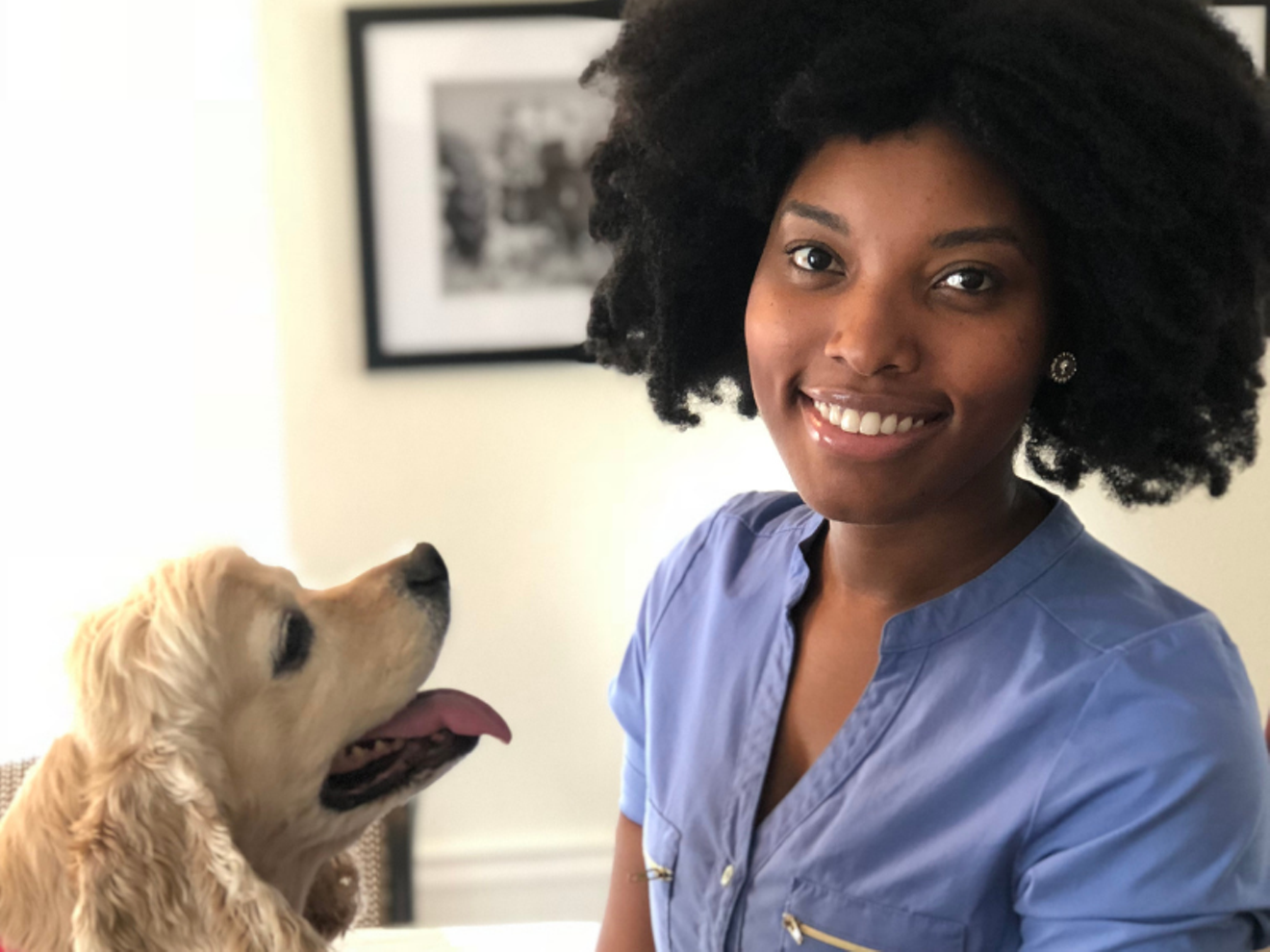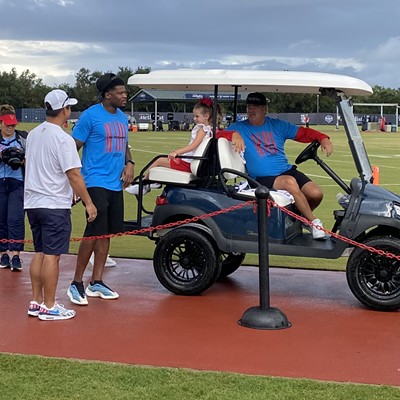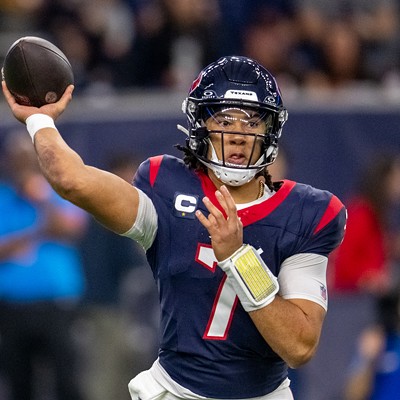“It was such a culture shock,” Glass said. “I went from being a person among a spectrum of folks to all of a sudden, I’m the representative of all Black people. Veterinary school is hard enough. I was very hyper aware of the music I listened to, how I dressed, my hair. If I arrived late because the bus was slow, there would be eye rolls and sighs, but someone else would come in after me and no one would pay attention to that.”
It turns out Eddie Murphy’s Dr. Doolittle was extraordinary in more ways than one. Less than 1 percent of all veterinarians in this country are Black (no data available yet regarding how many can speak to animals).
“I’m very happy when I see another Black veterinarian, like ‘wow there one goes,’” Glass said. “Like, ‘Oh my God, I saw a unicorn today.’”
Although Glass eventually overcame the barriers to become one of the very few Black veterinarians in the Houston area (and in the country), she’s still staring down some hurdles — like how to open her own clinic for her community in the Third Ward when she can’t afford the gentrified rent costs. And the profession has plenty of work to do, too.
But here in Texas, Black veterinarians and teachers are making those strides to overcome that disparity.
Getting the Hours
In 2013, 96.5 percent of all veterinarians were white, beating out farmers, mining machine operators, and speech-language pathologists to be the whitest profession in the country. And that’s not a coincidence.Like all kinds of medical school, veterinary school admissions are extremely competitive, with applicants commonly applying multiple times before receiving an acceptance letter. The more hours of animal-related experience an applicant has, the better their odds — some schools won’t even accept applications without a minimum of 100 or 200 hours. But people of color are disadvantaged from the start.
Glass said that most people in the profession knew they wanted to be veterinarians from a very young age. Recent surveys show 64.7 percent of white households own pets, while Black households are the least likely demographic to own pets at 36.9 percent. Without pets, Black households have no reason to even visit a veterinarian's office and are even less likely to see themselves reflected in the people working at an animal clinic.
Dr. Lillian Baker, who owns Baker's Mobile Veterinary Services, said that Black pet owners are also less likely to visit the veterinarian due to the culture around pet ownership in much of the Black community, although that is also changing with time.
“It’s just the old school mentality,” Baker said. “The Black clientele that I have, they're different from most Black pet owners, they understand now that the [pets] don't just go in the backyard, they're like family. And when you get to that point and you don't treat the pets like property, then you take better care of them and go to the vet."
Renters and people who live in apartments are also much less likely to own pets. When she was a 12-year-old animal lover growing up in Queens, New York, Dr. Niccole Bruno couldn’t have pets in her apartment, so she had her mom take her to Yonkers so she could shadow the closest Black veterinarian on the weekends.
“If you Google ‘veterinarian,’ all you see is white faces,” said Bruno, who is now the chief of staff at an animal clinic in Spring. “If you’re a 12-year-old and you look it up, you have to look past all the white faces to imagine yourself as one.”
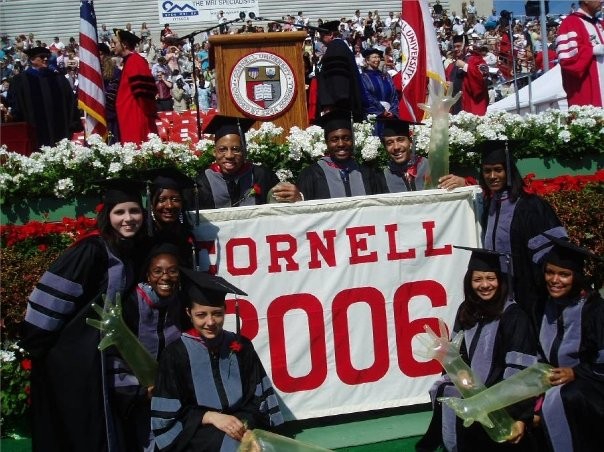
Dr. Niccole Bruno says her class at Cornell University's College of Veterinary Medicine was the most diverse class in the college's history.
Photo courtesy of Dr. Niccole Bruno
Marissa Runnels and her co-teacher Demond Spiller both once aspired to be among the small number of Black veterinarians. Now they’re teaching new generations of young people of color the skills they’ll need to break into the field. Together they run a pet care program at Nimitz High School in Irving Independent School District designed to help students overcome the barriers to entry.
The four-year program gives the students the ability to study for and obtain certificates in skills like grooming, pet CPR and first aid, and medical applications. Almost all of the 300 to 400 students in the program are minorities.
“The majority of our students strive to [go to veterinary school], but the honest truth is that they don’t get to because of that cultural barrier, which is [the belief] that when you graduate, you should go straight to work so you can help the family,” Runnels said.
The goal for most students in the program is to graduate as certified veterinary technicians, who earn on average $29,000 a year in Texas compared to $82,000 for veterinarians. As part of the program, the students have to go out and find internships at animal hospitals and get up to 300 hours of observation and skill hours. But even with those hours baked into the curriculum, students with less economic privileges still face barriers, like not having a car to drive to the internship.
“It's a big issue,” Runnels said. “We probably graduate four or five every year with the certification because they have those limitations. We're trying to get a bus, and this year they gave me a whole other class period off so I could drive students.”
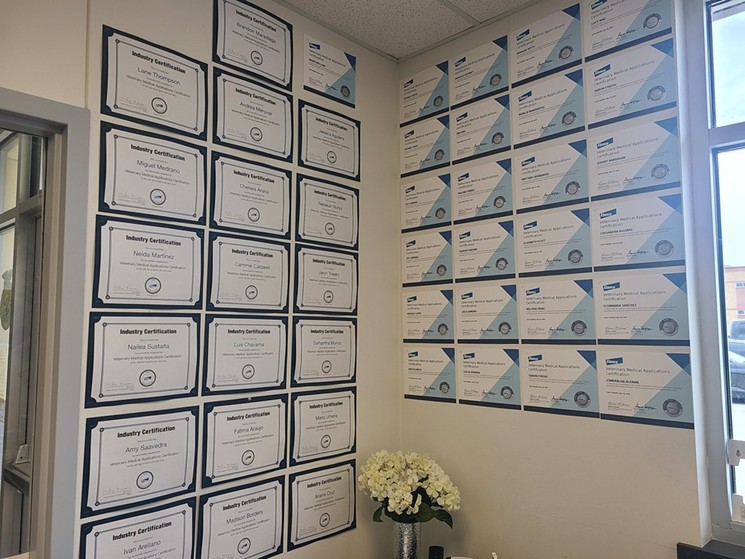
The walls in Marissa Runnels' office at Nimitz High School are covered in students' certificates in various animal skills.
Courtesy Marissa Runnels
While COVID-19 has thrown another wrench in those plans, it has also opened up an opportunity. Runnels said she’s working with the College of Veterinary Medicine at Texas A&M to create a virtual internship that would give students some of their necessary hours even as hospitals remain closed to interns.
The students would shadow veterinarians and technicians over video chat, observing everything from how to restrain an animal to how to place a catheter. The industry professionals can then sign off on those skills, a requirement to receive any certification. But the students also need to spend hours in clinics in addition to virtual hours in order to get their certificates, making the goal an even longer shot this year.
According to Runnels, in the past interns have been able to assist in surgery and emergency cases, but that of course won’t be the case in a virtual setting.
“I’m not good at learning by the book myself,” Runnels said. “This industry is very hands-on based. You have to be able to get those skills by touching and doing it yourself. But this is better than nothing.”
In a rare pandemic silver-lining, if the program works, it’ll stick around and keep giving underprivileged students access to the ability to apply for certifications and even eventually veterinary school."
This is the kind of program Baker needed growing up in Monroe, Louisiana. Even though she was still young when she knew she wanted to become a veterinarian, she still couldn’t get any hours.
“It has a lot to do with the city I come from. There are no Black veterinarians there,” she said. “Whenever I would try to go in and shadow a clinic, I would call ahead but when I got there and I wasn’t the complexion they thought I would be, they turned me away. They would say that they don’t actually allow shadowing anymore, but I would talk to other people who were not the same complexion as me and they would say that they shadow there all the time.”
Luckily, Tuskegee, the only historically Black college of veterinary medicine, didn’t hold that against her, and today she owns her own clinic in Cypress. But it’s never been easy.
“In these very small towns, there’s a monopoly,” Baker said. “Even after I was in veterinary school, in my fourth year when we had to go back home to do preceptorship, it was the same thing. Only the new clinic in town allowed me to do a preceptorship. Its unheard of in my city to be a vet as a female, but to be a Black vet as well? It’s unheard of.”
Like unicorns.
Opening Their Own Clinics
“Ownership, especially so soon out of school, was not encouraged. It was actually discouraged,” Baker said. Nevertheless, opening her own clinic was always in her plans.“It just came full circle,” Baker said. “My plan was to graduate and go back home, open my own clinic and be able to give opportunities to those who look like me, who are maybe going through the same thing that I was experiencing.”
She soon realized the pay rate in Monroe was not competitive enough for a new graduate with debt to make a living. But an opportunity came to work in Houston and after a few years working, she opened a mobile clinic based in Cypress.
Glass also now owns Personal Touch Veterinary Clinic, a mobile clinic that makes home visits across the Houston area. She says her next step to get a brick-and-mortar location with her partner, who is also a Black veterinarian.
“We want to provide good quality veterinary care to our community, which is the Third Ward community, and right now, the thing that has been holding it up has been the gentrification,” Glass said. "It's just been a lot of hush hush stuff, like we see this property and nothing's being done to it, let us come and help revitalize this corner. And we get told no, or we can only do it for two million dollars. It's been very frustrating.”
Glass said they’ve tried to contact several property managers, including the Midtown Redevelopment Authority which is developing a center for affordable housing and retail, and have received dead silence in return.
“If you're supposed to be serving the community, and we're from the community trying to serve the community, how are you serving the community if you can't even communicate?” Glass said.
Baker said she noticed the progress of the gentrification when she last did a client visit to the area a week before we talked.
“I was telling my husband, hey, it looks like they’re changing the Third Ward up, because it was, technically they call it the hood, but there are really really nice houses [right next to] an old rinky dink house, an abandoned house, another one, and then a nice gated house. I said, in about two or three years it's going to be only nice houses in that area and there probably aren't going to be a lot of Black people in Third Ward any more.”
Glass and her partner remain hopeful they can carve out a space for themselves and the future of Black veterinarians in the area.
“Because we’re both from Third Ward, we recognize that it’s very hard for students who look like us to enter the field, and a lot of us along the way get really discouraged because of all the gate keepers,” Glass said. “So the other reason we want to be in Third Ward is to provide that space for future veterinarians to get interning hours and even meet other Black veterinarians. I didn’t know it was possible until I started to see it for myself.”
Mentoring the New Generation
Bruno, who runs an animal hospital that’s a part of a group of clinics, said she’s been working with the corporate leadership to promote diversity and inclusion when it comes to hiring and retaining people of color.“Some of these things have been talked about for generations,” Bruno said. "We can't just work on getting people of color into veterinary schools. The profession needs to be inclusive so that when they graduate, there’s a place for them. The culture needs to change.”
Bruno said that aside from the principles of racial equity, the profession suffers from the lack of diversity.
“There are studies that show that increasing diversity in any occupation increases profit because you can increase services and have new ideas,” she said.
Glass said that while she was still working at a corporate animal clinic, a young woman reached out to her to ask if she could shadow her. She was more than happy to take the young woman under her wing, but management pushed back.
“I had to fight tooth and nail in order for them to even allow her to,” Glass said. But even that came with restrictions. “She couldn’t touch anything, she could barely breathe in the place. It was ridiculous. They were almost annoyed that I was even asking.”
Eventually, Glass told her to reach out to two other Black veterinarians in the area so that she could get experience she couldn’t get in that clinic.
“I’m so happy I fought for her to do that because I knew it was not the best kind of place for her to get enough exposure. And I'm happy to say now she’s in veterinary school and she was able to go all the way. And she’s going to become a wonderful veterinarian.”

